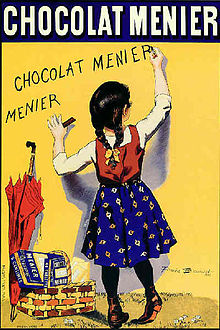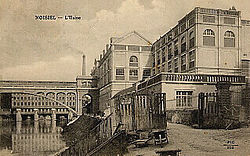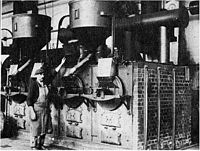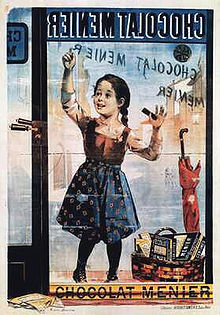- Menier Chocolate
-
The Menier Chocolate company (French: Chocolat Menier) was a chocolate manufacturing business founded in 1816 as a pharmaceutical manufacturer in Paris, France at a time when chocolate was used as a medicinal product and was only one part of the overall business.
Controlled and run by the Menier family for more than 150 years, the heads of Menier Chocolate company were:
- Antoine Brutus Menier (1795-1853) - founder
- Emile-Justin Menier (1826-1881) - sole CEO
- Gaston Menier (1855-1934) - COO
- Henri Menier (1853-1913) - CEO
- Hubert Menier (1910-1959) - co chief executive with Antoine
- Antoine Gilles Menier (1904-1967) - last CEO
In 1816, Antoine Brutus Menier founded the Menier Hardware Company in Paris. Although not trained as a pharmacist, he began preparing and selling a variety of powders for medicinal purposes. The business grew rapidly but for the first few years the company's production of chocolate was very limited as its primary usage was as a medicinal powder and for coating of bitter-tasting pills.
Contents
Factory at Noisiel
In 1825 the company began an expansion through the acquisition of a second production facility on land on the banks of the Marne River at Noisiel, at the time a small village of less than 200 inhabitants at the outskirts of Paris. Initially used as a grinding works for the production of medicinal powders, a modernization of the Noisiel facility in 1830 made it the first mechanized mass production factory for cocoa powder in France. Following the development of solid chocolate, Menier introduced to the market a block of chocolate wrapped in decorative yellow paper. By 1842, the success of the chocolate business led to another expansion of the Noisiel plant and by 1853 annual chocolate production reached 4,000 tons.
Under the leadership of the founder's son, Emile-Justin Menier, the company concentrated solely on the manufacturing of chocolate products. In 1864 he sold off the pharmaceutical manufacturing part of the business and began a period of expansion that made the Menier Chocolate company the largest chocolate manufacturer in France. Under Emile-Justin Menier, the company purchased cocoa-growing estates in Nicaragua along with sugar beet fields and a sugar refinery at Roye in the Somme in France.
Beginning in 1860, Emile-Justin Menier oversaw the addition of several new buildings then, after constructing a factory in London, England and a distribution center in New York City, in 1872 he initiated a major expansion that saw the construction of the most modern production facilities in the world. Designed by architect Jules Saulnier, many historians cite the building as the first true skeleton structure with exterior walls needing only simple infill.[1] The February 1997 issue of the Architectural Review called the 1872 iron and brick chocolate factory at Noisiel "one of the iconic buildings of the Industrial Revolution". In 1992, the factory was designated by the government of France as an official Monument historique and is on the list to be named a UNESCO World Heritage Site.[2]
 Menier factory floor, Noisiel, c. 1874
Menier factory floor, Noisiel, c. 1874
As a result of the factory expansions, by the mid 1880s production capacity at the Noisiel plant jumped to 125,000 tons annually and the company employed 2000 people. Because of the Menier company's rapid growth, the shortage of workers available from the small village forced the company to try to attract labor from other towns and cities. However, a lack of housing in Noisiel made that nearly impossible and as a result, in 1874 Menier completed construction of 312 residences on 30 hectares of land near the factory. They would build a school for their employees' children and three decades later, a senior citizens' home for their retired workers. In the 1870s, the Meniers also built the Noisiel town hall where a family member would serve as mayor without interruption from May 11, 1871 to November 8, 1959. At the 1878 World's Fair in Paris, the company was awarded seven gold medals plus the Grand Prize for the excellence of their products as well as citations for their modern production methods and the importance the company placed on the well-being of its employees.
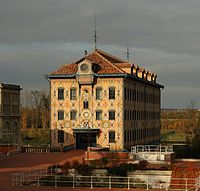 Saulnier's building, 2007
Saulnier's building, 2007
Following the death of Emile Justin Menier, in 1881 his sons Henri and Gaston assumed control of the business. As the eldest son, Henri Menier became the titular head of the company. Although involved in the business, he spent a great deal of his time pursuing various leisure interests and left much of the company's management to brother Gaston who would oversee a period of sustained prosperity. Of extreme importance to the sustaining of the Menier Chocolate Company's competitiveness were several internal and external developments in the second half of the 1870s and the early part of the 1880s. The Menier plant added modern refrigeration systems and in 1881 a railroad line was built to the Noisiel factory which reduced costs for incoming and outgoing freight and allowed for wider and faster distribution. Externally, Swiss chocolate manufacturers were making advancements in product development. They began mass production and promotion of milk chocolate and the new conching process provided a type of chocolate that consumers liked because it would melt in the mouth.
Pioneering advertising strategies
In 1893 the company began using advertising posters created by Firmin Bouisset featuring a little girl using a piece of chocolate to write the name Chocolat Menier on a wall or window. The small girl's sweet innocence essayed the sweet chocolate message through her "chocolate graffiti". It proved to be a highly successful image and became an internationally recognized symbol. Firmin Bouisset's image of the little girl would be featured on Menier's packaged products as well as on promotional items such as reusable tin ware, creamers, bowls, sugar dishes, plates, canister sets, and even children's exercise books. Original Menier posters and assorted products as well as reproductions are still much in demand today.
As part of its sales strategy, Menier introduced small dark chocolate sticks to be inserted into a piece of bread. To raise their profile and sell more product, on sidewalks in towns and cities all over France, the company set up "chocolate kiosques". Their hexagon shape and peaked roof became the standard for newspaper kiosques. Such was their popularity that for children, the company made plastic model kiosks as toy dispensers filled with tiny chocolate bars.
With their growing international presence, the Menier Chocolate Company exhibited at the 1893 World's Fair in Chicago where they were billed as the leading chocolate makers in the world. As the business continued to prosper, at the turn of the 20th century, more additions to the Noisiel plant were made including a major building that was one of the first to use reinforced concrete and, because of its appearance, was soon dubbed by locals as the "Cathedral." In addition, the company built Pont Hardi, a 44.5m long concrete bridge, a record at the time, across the Marne River to link the new building to the other plants. (photo)
The decline of a business empire
World War I marked the beginning of the decline of the Menier Chocolate company. While Europe was in turmoil and businesses there suffered greatly, rapid expansion was taking place in neutral Switzerland and in the United States where companies were untouched by the ravages of the war and who benefited from the influx of refugees that increased market size and provided the manual labor necessary for expansion. While the war raged on in France for four years, a Swiss company was able to introduce the first chocolates with a filling. By the end of the war, Menier's finances had been weakened while competition and technologies had substantially increased.
Gaston Menier died in 1934 and the onset of World War II five years later exacerbated the company's problems to an even much greater extent. Run by Hubert and Antoine Menier, neither had the capacity to deal with the problems. Despite the Menier Chocolate company's strong brand recognition and an effective marketing of children's books utilizing the fables of Jean de La Fontaine, by the 1950s the industry leader in France was being swamped by its competitors, rapidly losing both market share along with considerable amounts of money. Hubert Menier died in 1959 and Antoine would be the last Menier to run the business. Entering the 1960s, the Menier workforce had dropped to just over 250 from its peak of more than 2,000.
In 1960, the Menier company had no choice but to find a buyer and was merged with the Cacao Barry company and by 1965 the Menier family no longer held an interest in the company. The Menier factory was sold to Group Ufico-Perrier which became part of British confectioners Rowntree Mackintosh in 1971 who in turn was acquired in 1988 by the Swiss food and beverage giant, Nestlé S.A..
In the early 1990s, all production ceased at the Noisiel facility but in 1996, Nestlé France opened its headquarters in the main building while other buildings in the complex are now part of a chocolate museum with tours open to the public. Today, the Menier Chocolate Factory building on Southwark Street in London is a popular arts complex that incorporates an art gallery, restaurant, and theatre.[3]
See also
References
- ^ http://www.arch.mcgill.ca/prof/adams/arch251/winter1998/ha/feb18/feb18.htm arch.mcgill.ca
- ^ http://whc.unesco.org/en/tentativelists/1664/ whc.unesco.org
- ^ http://www.menierchocolatefactory.com/ menierchocolatefactory.com
In the French Language:
- Menier history by the city of Noisiel, France
- Menior Chocolate Company history
- Pere Lachaise cemetery info on the Menier family and its business
In the English Language:
External links
Categories:- Chocolatiers
- Menier family
- Companies established in 1816
- Food manufacturers of France
- Defunct companies of France
- Nestlé
Wikimedia Foundation. 2010.

